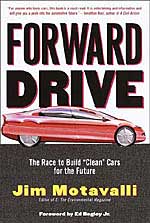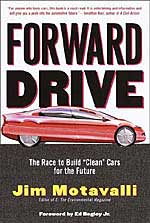This essay is adapted from Forward Drive: The Race to Build “Clean” Cars for the Future.
I loved cars long before I knew there was any reason to worry about their effect on the environment or be concerned about the smoke that poured from their tailpipes. In the 1960s, ignorance like mine was widespread in the United States, maintained by a powerful automotive lobby and a complacent federal government. Highway congestion, though already bad, was somewhat masked by an expanding national highway grid, and most people celebrated the migration to the suburbs that the new roads aided and abetted. Cars were equated with freedom, and ads of the period showed happy vacationing families riding in roomy sedans, with the uncrowded interstate stretching out in front of them.
The V-8 engine, dominant since the 1950s, and the “muscle cars” of the late 1960s and early 1970s were symbols of an impatient country on the move. The in crowd romanticized in the Beach Boys’ “I Get Around” could say, “We always take my car ’cause it’s never been beat.” The icon of the age was the AC Cobra, a tiny and barely controllable British sports car with a huge Ford 427 engine.

The AC Cobra — not an eco-icon.
I bought into all of this, subscribed to the car magazines, and put up posters of the Dodge Charger in my room. But on April 22, 1970, because my friends were going, I attended the first Earth Day celebration in Washington, D.C., and it became a turning point — for me and for many other Americans. Since then, our knowledge about the automobile’s effects on the environment has certainly grown. And most of the news we’ve gotten is bad.
All Choked Up?
If ever a human invention has reached a critical moment in its history, it is the internal-combustion automobile, whose 100th anniversary was celebrated in 1996. We are literally choking to death on our enduring love affair with the gasoline-powered car. Since 1969, the U.S. vehicle population has grown six times faster than the human population, 2.5 times faster than the number of households, and double the rate of new drivers. As Matthew L. Wald put it in the New York Times, “They bid fair to become the dominant life form.” Despite being only 5 percent of the world’s population, Americans own 34 percent of the planet’s cars and drive an estimated 2 trillion miles annually. Between 1900 and 1984, we sent more than 640 million motor vehicles to the scrap heap.

Valet parking?
In half the world’s cities, the biggest source of air pollution is exhaust emissions. In Athens, Greece, the death rate climbs 500 percent on bad-air days. In São Paulo, Brazil, dirty air and clogged streets have forced officials to set up a rotation system for drivers that keeps one-fifth of the city’s cars off the road at any given time. Cars are also a huge problem in Tel Aviv, Israel, where smog is predicted to reach Mexico City levels (the worst in the world, with ozone levels three times safe limits) by 2010; already, it has led to outbreaks of asthma and bronchitis in the city and in nearby Jerusalem. In Prague, Czech Republic, smog occasionally forces the police to set up roadblocks and keep all but essential traffic out of the city center.
And traffic congestion and gridlock turn commuting into a daily endurance test. In Bangkok, Thailand, for instance, rush-hour traffic struggles to reach a fast walk, and drivers carry portable toilets with them for the inevitable emergency. In Singapore, drivers pay a premium for licenses that allow them unlimited access to the highways.
In one year, the average gas-powered car produces five tons of carbon dioxide, which as it slowly builds up in the atmosphere causes global warming. Every gallon of gasoline burned in an automobile engine sends 20 pounds of carbon dioxide, containing five pounds of pure carbon, into the atmosphere. Cars and trucks produce by far the biggest share of fossil-fuel emissions (47 percent by one measure). Auto plants are also a significant source of emissions, particularly from their paint shops, though some manufacturers have switched to cleaner water-based paints. According to 1996 EPA data, a single Mitsubishi plant in Normal, Ill., produced 21.6 pounds of toxic chemicals per vehicle.
But even as we’re realizing what our continuing reliance on the private automobile is costing us, we’re adding another 50 million of them to the planet’s burden every year. By 2030, there could be 1 billion cars taking up space on the Earth — an astounding figure that means, in effect, that the auto industry will produce as many cars in the next 30 years as it did in its first century. Car making is now the largest manufacturing activity on earth.
But Don’t Despair …
As I looked at these trends, I found it wasn’t hard to imagine World War III being fought over the last few gallons of Middle East oil. But before despair grabbed hold, I began to hear about some new technologies that offered, if not a way out of auto addiction, at least an alternative to tailpipe asphyxiation, fossil-fuel dependence, and the swift onset of global warming.
The information I came across was often buried deep inside technical journals, or couched in the auto industry’s insider language. But it described a personal transportation revolution that was becoming tantalizingly close. The alternative propulsion systems I heard about weren’t exactly new — the history stretched back 160 years — but rapid technical advances were making them practical for the first time.

The Toyota Prius, a gas-electric hybrid.
Driven by air pollution legislation, the threat of global warming, and a suddenly animated international competition, carmakers were making quantum leaps forward in technology. Here, at last, were vehicles that promised to not only greatly reduce pollution but also to perform better, be more reliable, cruise farther, and last much longer than anything the public had ever seen.
This could be, in short, a whole new evolution of the automobile, at a time when such progress was desperately needed.Automakers are now beginning to deliver cars powered by high-efficiency hybrid drives (with both conventional internal-combustion power and electric motors) and emission-free fuel cells running on hydrogen.

The Honda Insight.
What’s more, fuel cells offer the tantalizing possibility of ushering in an entirely new energy economy. They may soon power our watches, our laptop computers, and our homes. If hydrogen is produced by renewable energy sources, such as photovoltaics or geothermal power, it can be a perfect zero-emission loop, with drinkable water the only byproduct. “It’s like a dream, isn’t it?” one auto company fuel-cell expert told me, and he’s right. The promise of fuel cells can realistically be compared in importance to Thomas Edison’s development of a workable incandescent light.
Progress has been rapid. Fuel-cell cars are on the road right now, and they could be in mass production as early as 2004. On two consecutive days just before Earth Day 1999, General Motors announced a major fuel-cell partnership with Toyota, and DaimlerChrysler unveiled the California Fuel Cell Partnership, which will put 50 of these high-technology cars on the state’s roads by 2003.
If You Can’t Beat ‘Em, Clean ‘Em
Environmentalists don’t love cars, and they shouldn’t. These “insolent chariots” have had an appalling cost in their first century, and making them “clean” won’t solve all the problems they cause. If transportation is to move efficiently in the new millennium, we’ll have to combine improvements in the personal automobile with a wide array of other reforms, including moratoriums on suburban sprawl, construction of new in-town housing, and development of an interconnected rapid-transit network.
But as America sprawls ever farther out from the city centers, where public transit works best, we’re only adding to our auto addiction. “The car will not vanish, so we must clean it up,” writes Hank Dittmar of the Surface Transportation Policy Project.
At the end of the 20th century, fuel-efficient and hydrogen-powered cars can seem like the answer to a question nobody’s asking. But the auto industry is, for once, looking ahead, and seeing not only the end of the oil era but also a global-warming crisis that won’t be easily solved without changing the way the world drives. The automakers certainly aren’t green, but their new cars represent a giant leap forward in the movement toward truly sustainable transportation.



